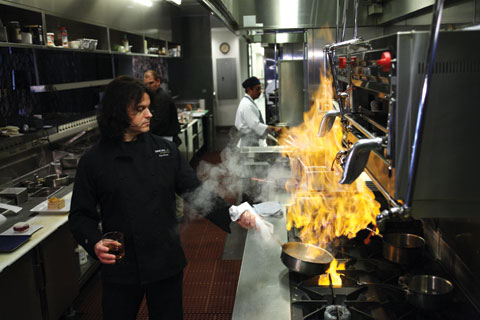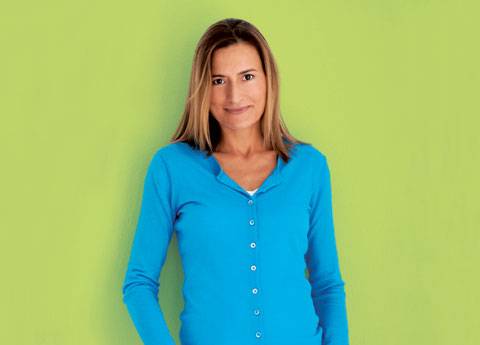Chef Kerry Simon of SIMON LA at Sofitel finds inspiration for his culinary creations from all things rock ‘n’ roll.
By Jeremy Lissek
Photography by Laura Wagner
There’s no exposure like Trump exposure.
Kerry Simon is not just a star chef, a super chef, or a celebuchef. He’s the Rock ‘n’ Roll Chef-Rolling Stone said so. Yet there isn’t one way to describe him, nor the kick-ass dishes he creates. He’s a mosaic: a cup of classical training, a tablespoon of street cool, a dash of outlaw integrity, a teaspoon of poetic sensitivity, a pound of integrity, a stalk of ingenuity, a sprig of existential thirst for knowledge, garnished with remarkable honesty. All sautéed in a lifetime of chasing his dreams.
The dream began years ago with a boy and his childhood summers in Bainbridge Island, just west of Seattle on the Puget Sound. A literal cornucopia was at his fingertips-apples and pears and rhubarb in his backyard, fresh fish and oysters straight from his buddies’ fathers’ fishing boats, and his own father, who was into everything from roasting salmon to Asian foods to granola and yogurt. As Simon says, figuratively, he “really beat it into us to eat healthy. It was a very artisanal type of vibe.” Although this was just the beginning of the process.
Simon grew up in Evanston, a suburb of Chicago’s North Shore region, and a decidedly different type of culinary environment-a land of beer and brats, steaks, pierogies and…pizza.
“My first job was at Little Caesars Pizza, trying to save up for an electric guitar,” Simon recounts. “A guy that worked with me left and opened his own restaurant, Dave’s Italian Kitchen, and he convinced me to come work with him.” And even though he thought he was going to be a musician (jamming with his 1963 black Fender Stratocaster is still his favorite indulgence), it didn’t take long for Simon, and others around him, to recognize his passion for cooking. “I was staying until four in the morning practicing dishes, experimenting with Julia Child’s and Graham Kerr’s cookbooks, making soufflés.” Dave saw him burning the midnight oil and told him about the Culinary Institute of America in Hyde Park, New York. Simon applied, but there was a five-year waiting list. “I was like, well, I guess that’s not the destination, because I didn’t have five years to wait. I didn’t know where I would be in five years.” In a way, he was both wrong and right, although there was no way he could have known at the time. How could he know that destiny was rearranging time and space for him? Fate didn’t want Kerry Simon to wait.
Not even a year after applying, the Culinary Institute contacted him. They had an opening. At CIA, Simon’s kitchen curiosities began to evolve into elements of surprise and contradiction. His weekends were spent in Upstate New York in an apprenticeship with three-star chef Jean Morel, providing the ultimate training, both hands-on and pedagogic, in the classic manner of French cuisine. “A lot of chefs went through his restaurant,” Simon says with deep reverence. “[Morel] really taught us the rules, structure, and discipline. It was like that ‘old school’ kind of place: the knives go here, the coffee there, the code of the chef, you mop the floors, you wash the dishes; it was the real deal, it taught me everything.”
Upon graduation, toting the triple-barrel arsenal of CIA fundamentals, Morel’s Zen-like wisdom, and his own keen sense of rebellious intuition, Simon strode into New York City, a rider on the storm. It didn’t take long for him to make his mark. The 17-hour days under such culinary luminaries as Jean-Jacques Rachou of La Côte Basque and André Soltner of Lutece went by in a blur. “It was pretty crazy,” Simon marvels at his being dazed and confused. “I was just a kid from Evanston and here I was making omelets for Henry Kissinger and an endless list of celebrities, from Andy Warhol on down, that I had no idea about. But I was learning.” He soaked up the stardust, until London started calling.
The young American was lured across the pond and employed as the personal chef for John Addey at Canonbury House in London, England. “I’d never been to Europe. It got me away from the restaurant scene for a while. I was burned out. London was refreshing. I got a whole different work schedule, reading more as well as looking at different cookbooks and different products; it was really invigorating. And I got to go to Paris and see all the markets there and eat at the restaurants; that year was stimulating to no end. I was seeing things that I had only read about and dreamed of.”
Following his return to the Big Apple, when Simon was working privately for insurance mogul Saul Steinberg, he wandered over to the Drake Hotel, where one of his inspirations, Louis Outhier, had just opened Lafayette. In the kitchen, the longhaired Simon met Jean-Georges Vongerichten. Simon laughs, “He told me, ‘Well, you’ll have to cut off your hair and come back tomorrow but I don’t have a position for you. You can work for free if you want.'” Always the wild one, he got a haircut but only shaved off one side of his long locks. Simon and Jean-Georges’ synergy, stoked by grand flights of wild creativity, led to instant success. Good reviews became a standard occurrence. “We ended up with three stars from the New York Times and it seems like it became four overnight. We changed the way people looked at the world of food. I got this idea for lobster oil, to use it as a vinaigrette, and next thing you know, we’re doing hundreds of flavored oils. Nobody else was doing it at the time so it was very inspiring and fun. It was like a playground.” Simon went from unpaid dough-boy to sous-chef to pastry chef, exceeding diners’ expectations with asparagus cookies and warm chocolate cake. He was a shooting star of “New American” cooking.
In 1989, Ivana Trump recognized Simon’s brilliance and hired him as executive chef at the Edwardian Room in New York’s Plaza Hotel-the youngest in the Plaza’s history. “It was my first chef job of that magnitude. It was intense pressure. It was like hot water running down my neck everyday. And then you know they had their own turmoil to deal with, and you just wanted to make them happy….They really got behind me and I couldn’t thank them enough for what they did for me. No chef before me had ever really been put in a position like that.”
There’s no exposure like Trump exposure. Before he and the Trumps joined forces, there were no young celebrity chefs. Simon changed all that; he was even photographed by David LaChapelle. Simon refreshed the concept of the chef’s table in the kitchen. It became so hot that it was booked months in advance by a parade of A-listers like Matt Dillon, Diane Keaton, Julian Schnabel, Michael Hutchence, and Debbie Harry. “I went from being pastry chef in the back kitchen to having David Bowie and Iman get engaged in my kitchen. I couldn’t believe it and I never took it for granted.” In 1991, Rolling Stone named him one of the top personalities of the year. Simon was the newest sensation.
Yet at the height of his elite status, he did what any proper iconoclast would do. He left to launch a whirlwind tour around the globe. He went to Russia, hung out in Copenhagen and the Far East. He went skiing in Aspen, and eventually wound up his sabbatical in Miami Beach. His intuition tugged at him as he wanted to expand the notion of simple comfort food with the devil-in-the-details knowledge of his classical training. Simon started at the Raleigh Hotel’s Blue Star, followed by Starfish, Max’s, and Mercury. While his meatloaf was becoming legendary, he was getting healthy. “I used to go kayaking in the bay and ocean with David Lee Roth. He’s the man with that stuff.”
A few years later, Simon rejoined Jean-Georges, but this time around as cuisine and design developer, a challenge that encompassed every phase of restaurant development. He continued to hone his skills by traveling the world developing, opening, or overseeing restaurants in Vegas, New York, Hong Kong, London, and Chicago. He finally settled between two major cities, in New York as partner at Mercer Kitchen and in Las Vegas as executive chef/partner at Prime. Then Elizabeth Blau and Peter Morton approached him in 2001 to settle in Las Vegas and open a restaurant bearing his name and showcasing his whimsical yet masterful “L’American” cuisine. In October of 2002, Simon Kitchen & Bar opened to extraordinary success and had a great run. In 2006, Simon went to California and opened SIMON LA in the Sofitel with Blau as a partner, which is still going strong.
“My food comes from all over the place, and it goes all over the place. You look at the menu and see that I have tuna tartare with lemongrass oil and wasabi caviar alongside meatloaf with garlic mashed potatoes. It leaves it open for anything I want to do, but the bottom line is you have to appeal to people. I never wanted to be one of those high-end kinds of restaurant with tasting menus. I always wanted to be fun and family style, where people can come and enjoy pizza or a yellowtail carpaccio. I love working with raw vegetables. I have a raw vegetable salad, a raw vegetable entrée, and even a raw vegetable dessert-there is no product that I don’t like to work with. I personally tend to eat more vegetarian and seafood, but that’s not to say I eat just one thing. I tend to eat healthier and drink a lot of vegetable juices. I watch what I eat [though he’ll still devour the double protein lettuce wrap at In-N-Out Burger], I don’t use a lot of butter, but instead mostly olive oils.” So maybe Simon doesn’t personally eat it, but individuals like Hugh Hefner love to pop in and order Simon’s junk food platter-an insane mix of cotton candy, homemade cracker jacks, Rice Krispies treats, doughnut holes, Sno Balls, cookies, cupcakes-complete with a vanilla milkshake to wash it all down.
His new ventures fulfill his yin-yang soul. He partners with Billy Cross and Mick Doohan for The Cathouse in Vegas, located in the Luxor, which opened several months ago and is based on the Electric Ladyland vibe of a 1930s bordello. And by May, he’ll be rolling the dice with Simon at Palms Place, where he partners with George Maloof to redefine the “green restaurant.”
“The Cathouse is more European-inspired food, which is right up my alley because of my classical training and my European travels. And at the Palms, I’ll have a sushi bar and finally be fooling around with Japanese food. So it’s two different things that are very inspiring. The dream continues.” Dream on in your soul kitchen, Kerry Simon. Dream on.





















